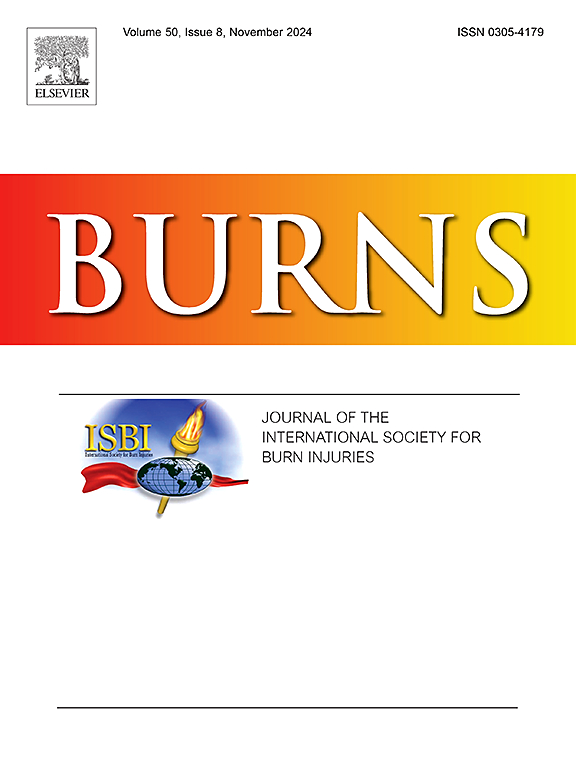Identification and quantification of physical activity in critically ill burn patients: A feasibility study
IF 3.2
3区 医学
Q2 CRITICAL CARE MEDICINE
引用次数: 0
Abstract
Background
Physical activity is essential in burn care to counteract the effects of severe burns and inactivity during hospitalization. However, detailed knowledge of performed physical activities is lacking. This study evaluated the feasibility of a dual accelerometer-based method to assess type, frequency, and duration of physical activity in critically ill burn patients during hospitalization.
Methods
A prospective observational study was conducted at the burn center of the Martini Hospital, Groningen, The Netherlands. Eligible were patients with a total body surface area (TBSA) burned of ≥ 15 % or an indication for intensive care. Patients wore two accelerometers, one on the chest and one on the diagonally opposite thigh. An algorithm converted accelerometer data into type, frequency, and duration of activities common for intensive care patients. An activity diary was used to assess non-wear time and its content, e.g., surgery.
Results
Five patients (20–60 years, 13–31 % TBSA burned, LOS 30–65 days) were included. Per patient, 14–49 days (17,380–61,796 min) could be analyzed of which 7–14 % was non-wear time. During wear time, 86–95 % of activities could be identified and quantified. However, processing the data was labor-intensive.
Conclusion
The dual accelerometer-based method proved feasible for research purposes. For clinical application, further refinement of data processing is required.
鉴定和量化危重烧伤患者的身体活动:可行性研究。
背景:身体活动在烧伤护理中是必不可少的,以抵消严重烧伤和住院期间缺乏活动的影响。然而,缺乏对进行的体育活动的详细了解。本研究评估了一种基于双加速度计的方法评估危重烧伤患者住院期间身体活动的类型、频率和持续时间的可行性。方法:在荷兰格罗宁根Martini医院烧伤中心进行前瞻性观察研究。符合条件的是烧伤总体表面积(TBSA)≥15%或有重症监护指征的患者。患者佩戴了两个加速度计,一个在胸部,另一个在对角线对面的大腿上。一种算法将加速度计数据转换为重症监护患者常见的活动类型、频率和持续时间。使用活动日记来评估非磨损时间及其内容,例如手术。结果:5例患者(20 ~ 60岁,13 ~ 31% TBSA烧伤,LOS 30 ~ 65 d)。每位患者可分析14-49天(17,380-61,796分钟),其中7- 14%为非磨损时间。在磨损期间,86- 95%的活动可以被识别和量化。然而,处理数据是一项劳动密集型工作。结论:基于双加速度计的方法是可行的。对于临床应用,需要进一步细化数据处理。
本文章由计算机程序翻译,如有差异,请以英文原文为准。
求助全文
约1分钟内获得全文
求助全文
来源期刊

Burns
医学-皮肤病学
CiteScore
4.50
自引率
18.50%
发文量
304
审稿时长
72 days
期刊介绍:
Burns aims to foster the exchange of information among all engaged in preventing and treating the effects of burns. The journal focuses on clinical, scientific and social aspects of these injuries and covers the prevention of the injury, the epidemiology of such injuries and all aspects of treatment including development of new techniques and technologies and verification of existing ones. Regular features include clinical and scientific papers, state of the art reviews and descriptions of burn-care in practice.
Topics covered by Burns include: the effects of smoke on man and animals, their tissues and cells; the responses to and treatment of patients and animals with chemical injuries to the skin; the biological and clinical effects of cold injuries; surgical techniques which are, or may be relevant to the treatment of burned patients during the acute or reconstructive phase following injury; well controlled laboratory studies of the effectiveness of anti-microbial agents on infection and new materials on scarring and healing; inflammatory responses to injury, effectiveness of related agents and other compounds used to modify the physiological and cellular responses to the injury; experimental studies of burns and the outcome of burn wound healing; regenerative medicine concerning the skin.
 求助内容:
求助内容: 应助结果提醒方式:
应助结果提醒方式:


